What Is A Steelhead? Is It A Salmon Or Trout?
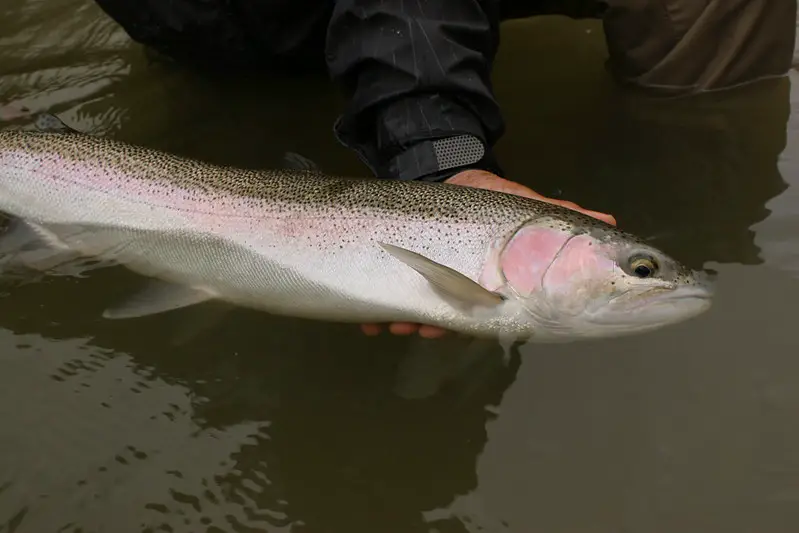
What is a steelhead? I’ve heard steelhead called just “steelhead”, I’ve heard it called a “steelhead trout”, and while some anglers say a steelhead is actually a trout, others say a steelhead is actually a salmon and it belongs in the salmon family.
There are other local nicknames for steelhead, such as silvers, bows, or just rainbows.
I have read this from educational sources ” Rainbow trout and steelhead are ray-finned fishes in the salmon family”.
Even Oceans and Fisheries Canada describes BC steelhead as “as a type of Pacific salmon.”
Yet salmonfacts.org states, “Steelhead fish is a trout, as it belongs to the rainbow trout species.” and idaho.gov states, “Steelhead are native rainbow trout.”
With all of this confusion, what the hell is a steelhead?
What is a Steelhead?
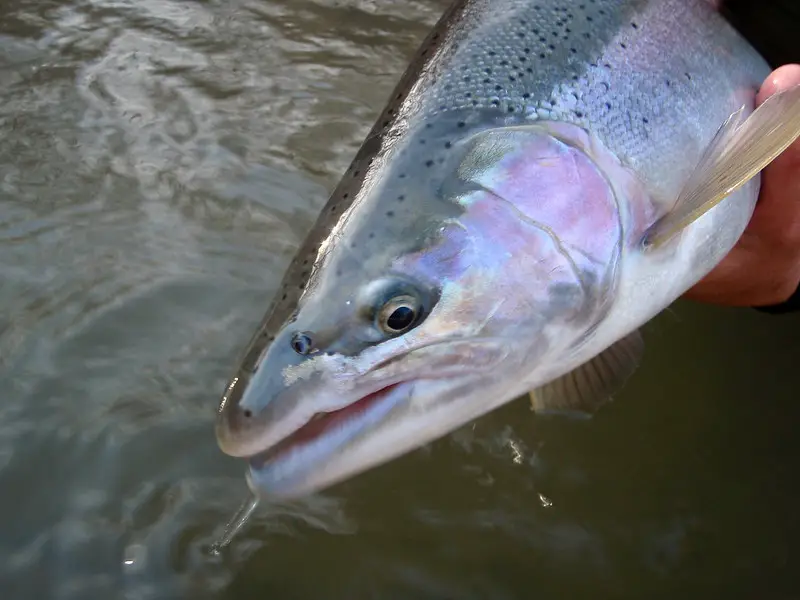
Steelhead is a name given to an anadromous form of rainbow trout, with the scientific name Oncorhynchus mykiss, which belongs to the trout family.
But, that is still debatable since on the Fisheries and Oceans government website is states “Steelhead were at one time considered a trout species but have been discovered by biologists to more closely related to Pacific salmon than other trout”.
But with that said, steelhead are still recognized by most organizations and governments to be in the trout family.
Anadromous here refers to the migratory nature of the fish from a freshwater river where they are born to the saltwater ocean, or one of the great lakes, where they spend a good part of their lives, and then return back up the river for the purpose of spawning.
Steelhead trout are indigenous to the Pacific coasts of North America and are closer to being related to the Salmonidae family, which includes the likes of salmon, trout, and chars.
The name “Steelhead” sterns from the fact that they procure more silvery markings than other Rainbow trout, influenced by their saltwater environment.
Steelhead in the oceans or lake or ones that have recently entered the river are often silver sided and whitish. Steelhead that remain in the river for weeks or months, or are in the middle of spawning will darken with hues of green, more black spots, and they will have more prominent red or pink stripes down the lateral line and on the cheeks.
As much as steelhead are a type of trout, they act and behave a lot like the salmon.
Steelhead generally seem to be more related to salmon than their trout family since they migrate; however, unlike salmon, they spawn in the spring, and they don’t die after spawning.
In fact, a lot of people interchange the two species of fish and find it difficult to tell the difference between a steelhead from a Pacific salmon.
Steelhead Life Cycle
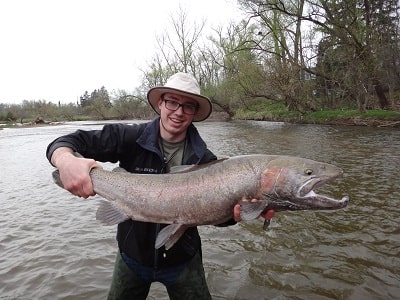
Juvenile steelhead spend their first years in their native freshwater streams for about 2 years for development and afterward migrate to the saltwater Ocean to spend their adult lives. On maturity and readiness to spawn, that is, after about one or two years, again, they migrate back to their native streams.
Their migration between freshwater and saltwater is one characteristic that differentiates them from rainbow trout that remain in freshwater all their lives. The upriver migration is generally when they are targeted by anglers as they can be found almost every month of the year.
Depending on when these adult steelhead return to freshwater, they are categorized as either summer-run or winter-run.
Winter-run Steelhead
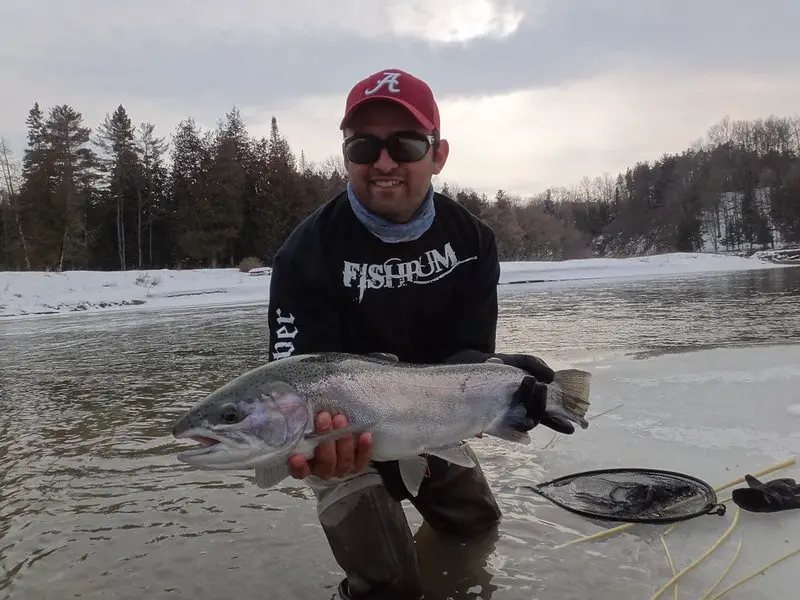
Simply put, winter-run steelhead enter the freshwater during the winter months, from as early as November through to May. This category of steelhead are predominately at a relatively developed stage of maturation and spawn shortly after.
This winter-run category of steelhead are generally larger than the summer-run and more aggressive as well.
Summer-run steelhead
On the other hand, summer-run steelhead begin to enter freshwater during the spring and summer, from as early as May.
Unlike their winter counterparts, summer-run steelhead begin their spawning journey sexually immature. They will remain in the river for several months in freshwater to complete their maturation process before spawning in late winter and early spring.
Despite the difference in their reproductive maturity and time of entering the river, both runs of steelhead still end up spawning in the spring or early summer. Some rivers enjoy both types of runs and some enjoy just one of the two.
Do Steelhead Die After Spawning?
Unlike their salmon counterpart, steelhead don’t die after finishing their spawning runs, but are capable of spawning multiple times. However, because of the high rate of mortality associated with this upriver migration, only a percentage of steelhead end up spawning multiple times.
What Are Steelhead Traits and Behaviors
If you are planning to spend a lot of time fishing for steelhead, you’ll likely need to know how to tell their difference from other similar species like rainbow trout and salmon.
There are subtle elements that can help clearly spot and identify a steelhead even when placed on display with the likes of rainbow trout and salmon.
Body Coloration Of Steelhead
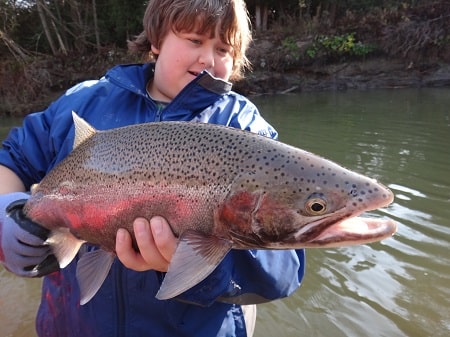
Steelhead have chrome-colored or lighter silvery palettes on their body, as opposed to trout with olive-green or blue-green hue, a dark back, and a bright, silvery belly.
After being in the river for a week or two, similar to trout, they start to take a pink-colored stripe that runs from tail to head, but is less intense and less bright. This is visible on their gill plates and sides.
Their upper body parts and tails are also characterized by black spots.
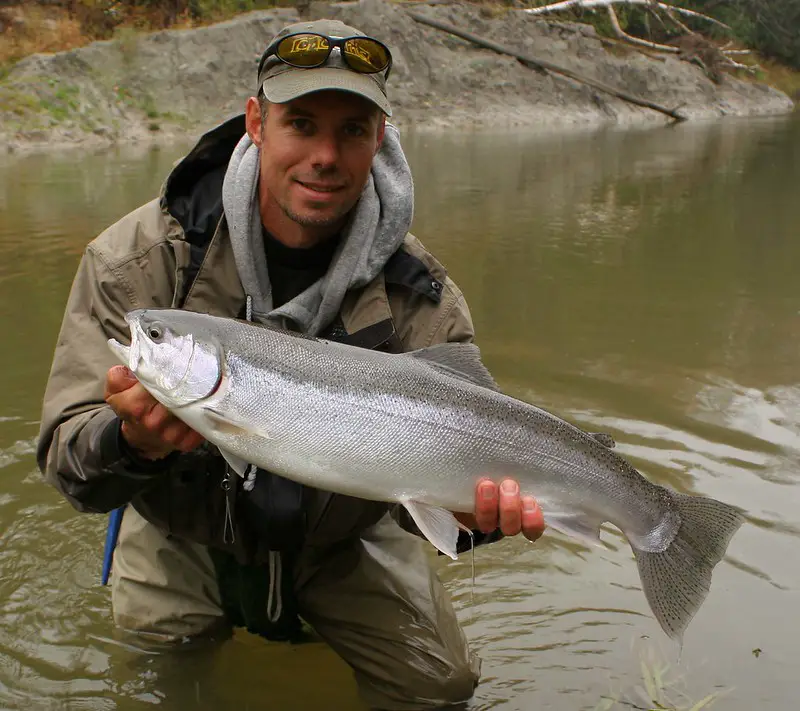
This change of color is influenced by their migration from saltwater into a freshwater environment. The longer they stay in the river, often, the darker in color they will get.
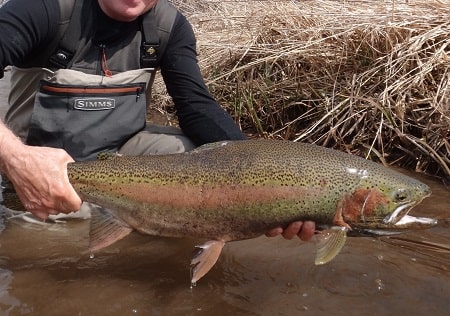
On return to their freshwater origin, they will gradually lose their silvery coloration back to the darker-bodied trout.
Average Size Of Steelhead
The average size of an adult rainbow trout range from 12 to 16 inches, and have an average weight of between 1 and 3lb. Steelheads, on the other hand usually attain a much bigger average size than that.
This difference in size and weight is based on the theory that there is an abundance of food in saltwater.
The average length of steelhead range from 20 to 25 inches, and their average weight ranges from 4 and 8lbs. Ultimately, steelhead can reach as much as 45 inches in length, and around 50lb in weight, however, attaining such enormous size is very rare.
Diet and Feeding
Steelhead generally have a slow attack speed and this affects their feeding habits, making them less predators of quick fish than their salmon counterparts.
They move to deeper waters and will feed on slower fish such as sticklebacks and accumulation of bugs, instead of the likes of alewives and smelt. They will also eat anything from aquatic insects and zooplankton.
As they migrate to saltwater environments, they get to feed on a variety of fish such as mollusks, crabs, shrimps, eggs, crustaceans, and other species of trout.
How To Determine The Gender Of A Steelhead
If you’re devoted to the pursuit of trout or raise trout for food, knowing the sex or gender of a trout is important to you.
There are few things that can help tell a male or a female steelhead. Similar to the Pacific salmon, the male steelheads have a longer jawline than females, which can be seen from the knob that forms on the tip of the male jaw.
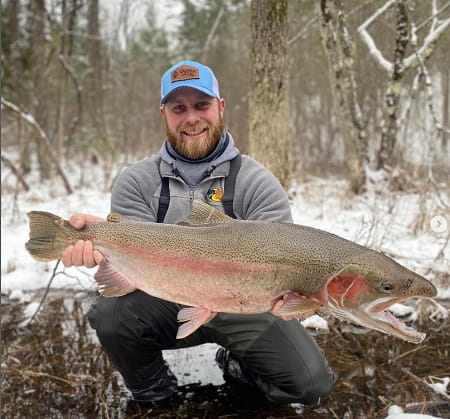
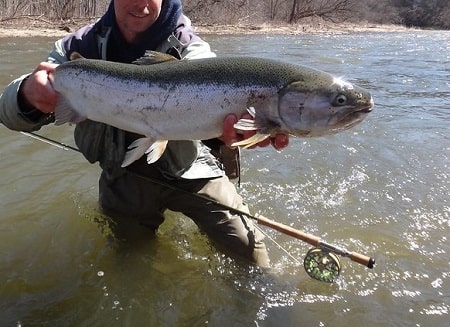
The male steelhead’s head is larger than a female’s. Male steelhead can also be identified from their convex-sloped forehead that points out at the nose, whereas the females’ head flows seamlessly to the tip of the nose. Male steelhead are taller and narrower compared to females. This is because the body of a male is compressed laterally, while that of a female is round. This can be seen by looking at the steelhead head-on or from above.
Furthermore, the adipose fins on a buck can be two to three times larger than on a hen. Bucks also have significantly longer teeth and fangs than hens.
How to Fish for Steelhead
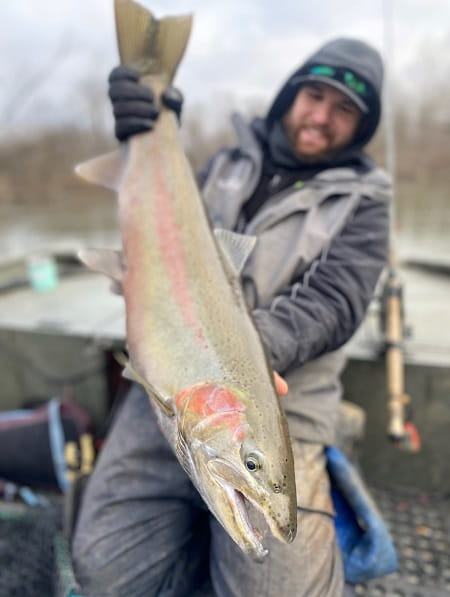
Anglers begin their hunt for steelhead the moment they enter the rivers for spawning. Some anglers will also troll for them out in the ocean.
As we already discussed, this return of steelhead for their spawning is generally categorized as either summer-run or winter-run.
Oftentimes, these steelhead runs are triggered by rain events, water temperatures, and the direction of the wind.
I discuss more on how these conditions trigger steelhead runs and how to fish for them successfully here. The river condition prevalent at any given time will determine how I go about fishing for steelhead, from the baits to use, the setup, leader and casting angles, my approach, the fishing methods, and more.
The Best Methods for Steelhead Fishing
When it comes to steelhead fishing methods, there are a variety of methods for anglers to choose from. Generally, the best methods to fish for steelheads and catch them include the following methods: float fishing, drift fishing, fly fishing, plunking, and bottom bouncing.
However, I increase my chances of catching the most steelhead when I use a technique suited for the location and situation.
In my several years of experience as a professional river guide and angler, I have used different fishing methods under different fishing conditions. If you want to learn more about the best steelhead fishing methods in different rivers and conditions, you can check out my article on Best Way to Catch Steelhead in Rivers.
The Best Baits for Steelhead Fishing
The choice of bait also influences the outcome of my steelhead fishing, making it more effective. The best bait should imitate the natural food of a steelhead trout’s diet.
As much as there are a lot of steelhead baits out there, the best of them are worms, flies, beads, and roe.
To get the most out of a bait and to increase the amount of fish I will catch, I ensure my bait is suited for the particular fishing condition and season.
I discuss the best baits for steelhead fishing and how to fish them under different river conditions on my page: Best steelhead baits.
Tight Lines
Graham
